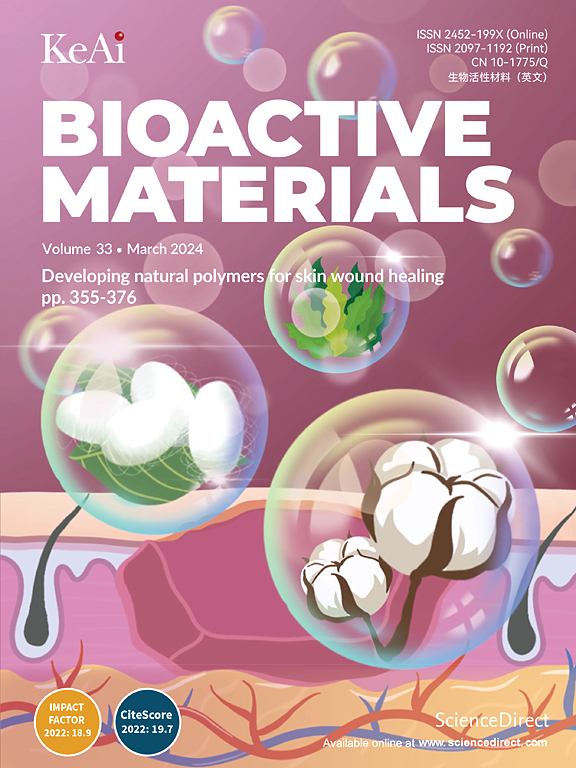Semi-synthetic fibrous fibrin composites promote 3D microvascular assembly, survival, and host integration of endothelial cells without mesenchymal cell support
IF 18
1区 医学
Q1 ENGINEERING, BIOMEDICAL
引用次数: 0
Abstract
Vasculogenic assembly of 3D capillary networks remains a promising approach to vascularizing tissue-engineered grafts, a significant outstanding challenge in tissue engineering and regenerative medicine. Current approaches for vasculogenic assembly rely on the inclusion of supporting mesenchymal cells alongside endothelial cells, co-encapsulated within vasculo-conducive materials such as low-density fibrin hydrogels. Here, we established a material-based approach to circumvent the need for supporting mesenchymal cells and report that the inclusion of synthetic matrix fibers in dense (>3 mg mL-1) 3D fibrin hydrogels can enhance vasculogenic assembly in endothelial cell monocultures. Surprisingly, we found that the addition of non-cell-adhesive synthetic matrix fibers compared to cell-adhesive synthetic fibers best encouraged vasculogenic assembly, proliferation, lumenogenesis, a vasculogenic transcriptional program, and additionally promoted cell-matrix interactions and intercellular force transmission. Implanting fiber-reinforced prevascularized constructs to assess graft-host vascular integration, we demonstrate additive effects of enhanced vascular network assembly during in vitro pre-culture, fiber-mediated improvements in endothelial cell survival and vascular maintenance post-implantation, and enhanced host cell infiltration that collectively enabled graft vessel integration with host circulation. This work establishes synthetic matrix fibers as an inexpensive alternative to sourcing and expanding secondary supporting cell types for the prevascularization of tissue constructs.

半合成纤维蛋白复合材料促进三维微血管组装,存活,和宿主整合内皮细胞没有间充质细胞的支持
三维毛细血管网络的血管生成组装仍然是组织工程移植物血管化的一种有前途的方法,这是组织工程和再生医学中一个重大的突出挑战。目前血管生成组装的方法依赖于将支持的间充质细胞与内皮细胞一起包被,共包被在有利于血管形成的材料中,如低密度纤维蛋白水凝胶。在这里,我们建立了一种基于材料的方法来避免对间充质细胞的支持,并报道在致密的(3mg mL-1) 3D纤维蛋白水凝胶中包含合成基质纤维可以增强内皮细胞单培养中的血管生成组装。令人惊讶的是,我们发现,与细胞粘附合成纤维相比,添加非细胞粘附合成基质纤维最能促进血管生成组装、增殖、血管生成、血管生成转录程序,并额外促进细胞-基质相互作用和细胞间力传递。通过植入纤维增强预血管构建体来评估移植物与宿主血管的整合,我们证明了在体外预培养期间增强血管网络组装的叠加效应,纤维介导的内皮细胞存活和植入后血管维持的改善,以及增强的宿主细胞浸润,这些共同促进了移植物血管与宿主循环的整合。这项工作建立了合成基质纤维作为一种廉价的替代来源和扩大次级支持细胞类型,用于组织结构的预血管化。
本文章由计算机程序翻译,如有差异,请以英文原文为准。
求助全文
约1分钟内获得全文
求助全文
来源期刊

Bioactive Materials
Biochemistry, Genetics and Molecular Biology-Biotechnology
CiteScore
28.00
自引率
6.30%
发文量
436
审稿时长
20 days
期刊介绍:
Bioactive Materials is a peer-reviewed research publication that focuses on advancements in bioactive materials. The journal accepts research papers, reviews, and rapid communications in the field of next-generation biomaterials that interact with cells, tissues, and organs in various living organisms.
The primary goal of Bioactive Materials is to promote the science and engineering of biomaterials that exhibit adaptiveness to the biological environment. These materials are specifically designed to stimulate or direct appropriate cell and tissue responses or regulate interactions with microorganisms.
The journal covers a wide range of bioactive materials, including those that are engineered or designed in terms of their physical form (e.g. particulate, fiber), topology (e.g. porosity, surface roughness), or dimensions (ranging from macro to nano-scales). Contributions are sought from the following categories of bioactive materials:
Bioactive metals and alloys
Bioactive inorganics: ceramics, glasses, and carbon-based materials
Bioactive polymers and gels
Bioactive materials derived from natural sources
Bioactive composites
These materials find applications in human and veterinary medicine, such as implants, tissue engineering scaffolds, cell/drug/gene carriers, as well as imaging and sensing devices.
 求助内容:
求助内容: 应助结果提醒方式:
应助结果提醒方式:


